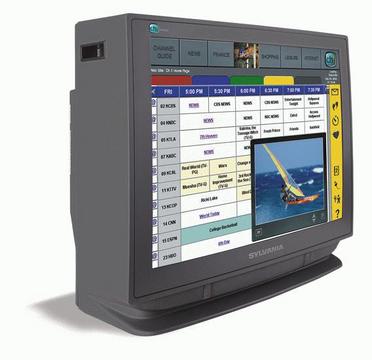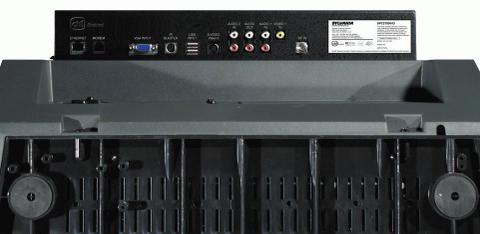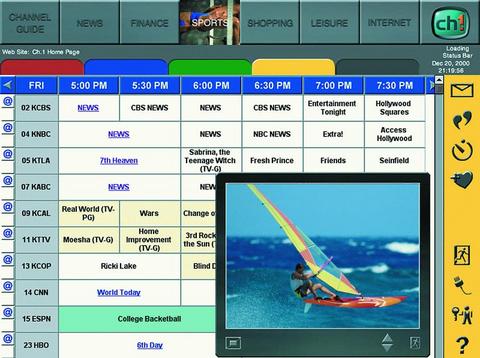Sylvania TV
Your next big-screen TV will have Linux in it. The only question is whose GUI environment and network services will run on top of Linux. A Santa Ana, California company called Ch.1, together with their licensee, Sylvania Computer Products, have big plans for an internet appliance in a TV that is combined with a home services offering. To facilitate this, Ch.1 combined an HDTV (High Definition Television) display with software that doesn't reduce TV customers to second-class web surfers.
Unlike most embedded vendors, or as most vendors wouldn't like to admit, Ch.1 has done the same project for two embedded OSes--first with QNX, and now a Linux port. This rare, controlled experiment gave us a chance to ask about the advantages and disadvantages of taking the Linux path.
First off, this is not a WebTV box. It's not a hack on the side of, or a box on top of, the old NTSC (National Television Standards Committee) kludge. Ch.1 is starting with an HDTV display and that makes a difference, said Rey Roque, VP of product development for Ch.1. WebTV and similar products haven't taken off because regular TVs don't have high enough quality to support browsing many popular web sites.
"NTSC displays 180 lines at best. You basically see a quarter of a given web page", Roque said. And since many web sites use intense colors, he added that WebTV has to "have code just to alter that color to make it acceptable on television sets". "We don't have to do any of that starting off with an XGA-compatible platform."
Ch.1 started off working with Princeton Graphic Systems, a high-end home theater vendor. Because there's little HDTV on the air, Ch.1's original mission was to use the Web as a reason to get people to upgrade to a monitor-class display, even though The Dukes of Hazzard is still coming through in old-fashioned NTSC.
The front view looks good, and inside the box it's basically a PC based on an National Semiconductor Geode processor, with 64MB of RAM and 16MB of Flash. Ch.1 had to develop Linux drivers for the TVIA chipset, but modem and network chipsets are commodity hardware and can be swapped out if a better price comes along.
Ch.1 developed the original version of its platform on QNX, and Princeton has already released a high-end home theater TV, sold through custom electronics stores, which includes the QNX-based version. So why the switch to Linux? Flexibility and easier driver development.
"The license fee of a QNX vs. a Linux implementation was a wash. It's really the versatility within the Linux OS that drove us to go to that environment", Roque said.
Porting took about 120 days and was relatively trouble-free. Ch.1 did need to do some device driver work, though, including drivers for the TVIA chipset and for the TV's parental control hardware.
Device driver development "was actually easier to do on the Linux side because the hardware partners we had all had some kind of Linux program or Linux support. QNX was more of a custom type of driver development. We had a lot of work done within their services group", Roque said. "As far as Linux device driver development went", he said, "I don't think that we had that much trouble finding Linux-capable people. We've hired as far out as London and as close as San Jose and Irvine. Being flexible in terms of geography helped."
For QNX, Ch.1 used QNX's Voyager browser, a Spyglass derivative. The Linux version uses Opera, which is featureful enough that people actually choose it as a desktop browser. Opera supports modern HTML features and offers a large selection of plugins.
"We don't really plan to support the universe of plugins, basically because of the footprint", Roque said. 64MB isn't enough space for everything, and Ch.1 will have to select the most popular plugins. And, licensing plugins for embedded applications is more difficult than the simple click-through process that an end user goes through. They already support RealPlayer, which may indicate that RealNetworks is getting its act together on licensing its player to embedded vendors.
Since there's no software on board to deal with word processor documents, spreadsheets or some other common e-mail attachment formats, Ch.1 deployed Linux-based, back-end servers to convert the files to HTML. (Maybe this means we'll finally be able to read the punch line to the "Snow White was turning 18" e-mail virus safely.)
Ch.1 has written its own GUI toolkit and, besides web browsing, offers other internet services such as IMAP and POP e-mail, a channel guide, a Jabber-based instant-messaging client and on-line games. Other plans include an optional webcam, so when you're not watching your TV you can at least watch the people who are. "Ch.1 is a platform that brings IP (Internet Protocol) to television. It's really more than browsing the Web", Roque said.
Since Ch.1 TVs have both Ethernet and a modem, the Net services are available two ways: about $20 US monthly with dial-up or $10 if you use your existing connection. There's no wireless option yet, but the company is looking at 802.11b. And, everything works if the TV is behind one of those ubiquitous Linksys NAT (Network Address Translation) "home firewall" boxes.
Ch.1: www.ch1.com
Heather's Dukes of Hazzard Page: www.geocities.com/TelevisionCity/9182/
Sylvania Computer Products: www.sylvaniapc.com/1Products/products.html
Don Marti is the technical editor for Linux Journal.
email: dmarti@ssc.com






_0bba8.png?itok=9TLc0cVH)


